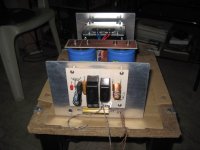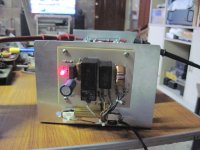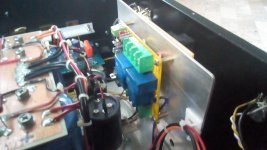I think the idea of those diodes was for protection of the amp if the supply was accidentally connected backwards, but likely they would just be an indicator that it happened because they would be disintegrated. They should be enough to blow the rail fuses in that situation though.
Last edited:
In a nushell both. Prevents amplifier and speaker damage.
Say the VCC line breaks for whatever reason from the Power supply.
As the OPS NPNs source current to the load, and their collectors sink current from VCC, they will bring the VCC line down. I.e. the VCC line voltage will come down as you discharge the rail decoupling caps. The VCC line will come down until D8 turns on and holds it at -VDiode.
Amplifier:
At this point a large part of the electronics in the amp have collapsed in some way or another, i.e. the amp is non functional. But clamping the supply will prevent VBE's from getting reverse biased excesively and prevents damage. If you think about it, the only 'hard' voltage in the amp is ground, everything else can move. So if power is removed, every voltage at every node reverts to ground. So clamping to ground is a good idea in power loss situations.
Speaker:
If the VCC rail is allowed to collapse further, it may pull the amp output to negative DC voltages (Assuming the VEE line is still active) which will destroy the speaker.
Say the VCC line breaks for whatever reason from the Power supply.
As the OPS NPNs source current to the load, and their collectors sink current from VCC, they will bring the VCC line down. I.e. the VCC line voltage will come down as you discharge the rail decoupling caps. The VCC line will come down until D8 turns on and holds it at -VDiode.
Amplifier:
At this point a large part of the electronics in the amp have collapsed in some way or another, i.e. the amp is non functional. But clamping the supply will prevent VBE's from getting reverse biased excesively and prevents damage. If you think about it, the only 'hard' voltage in the amp is ground, everything else can move. So if power is removed, every voltage at every node reverts to ground. So clamping to ground is a good idea in power loss situations.
Speaker:
If the VCC rail is allowed to collapse further, it may pull the amp output to negative DC voltages (Assuming the VEE line is still active) which will destroy the speaker.
I think the idea of those diodes was for protection of the amp if the supply was accidentally connected backwards, but likely they would just be an indicator that it happened because they would be disintegrated. They should be enough to blow the rail fuses in that situation though.
That is a good point too.
i have a suggestion, for the grounding, you can just label them Gi for the input ground, and Gp for the power ground....
Gi goes to any metal chassis connection point close to input jacks..
Gp goes to psu central ground connection point..
btw, my beef with this amp is the lack of SOA protection on board, so we took care of that and came up with a SOA circuit on board....
speaker time delay relay cum dc detector is a must in my builds...
so with a soft start circuits since i tend to use largish filter caps, 68kufd//10kufd @63wvdc...
Gi goes to any metal chassis connection point close to input jacks..
Gp goes to psu central ground connection point..
btw, my beef with this amp is the lack of SOA protection on board, so we took care of that and came up with a SOA circuit on board....
speaker time delay relay cum dc detector is a must in my builds...
so with a soft start circuits since i tend to use largish filter caps, 68kufd//10kufd @63wvdc...
Attachments
That is a good point too.
the practice of using these flyback diodes goes back to the 70's...
back emf of speakers are pushed back to the amplifier outputs so that these diodes lead these voltages back to the psu grounds...thru the filter caps...
i have a suggestion, for the grounding, you can just label them Gi for the input ground, and Gp for the power ground....
Gi goes to any metal chassis connection point close to input jacks..
Gp goes to psu central ground connection point..
What do you mean with "any metal chassis connection point close to input jacks.."? I am assuming you mean the ground connection of the RCA connector, right?
Last edited:
Perhaps this will be of some help:http://hifisonix.com/wordpress/wp-content/uploads/2019/02/Ground-Loops.pdf
R4 on the board is a Humm Breaking resistor, it reduces currents flowing around the interconnects (Cross Channel Ground Loop). You isolate the RCA from the chassis for this to work and only connect the 0V of the PSU/AMP to the chassis, preferably via a Ground Loop Breaker.
R4 on the board is a Humm Breaking resistor, it reduces currents flowing around the interconnects (Cross Channel Ground Loop). You isolate the RCA from the chassis for this to work and only connect the 0V of the PSU/AMP to the chassis, preferably via a Ground Loop Breaker.
Yes, these are D4 and D5. I was puzzled by D8 and D9, though.the practice of using these flyback diodes goes back to the 70's...
back emf of speakers are pushed back to the amplifier outputs so that these diodes lead these voltages back to the psu grounds...thru the filter caps...
Best regards!
Yes, these are D4 and D5. I was puzzled by D8 and D9, though.
Best regards!
those diodes are idiot proof protection, if you happen to reverse the psu polarity, these diodes protect the output trannies from damage, i would say cheap protection...
i would even suggest those diodes be in series, so that inadvertent reversal of psu leads would not cause damage, not even a fuse blow as in the case of d8d9....
D8,D9 can also be in series with the boards forward biased, a schottky low loss diodes will prevent amplifier damage to output devices in case the user happened to accidentally reversed the psu connections...no fuse blows, the amp simply will not work...
This is an educated guess:
They clamp the supplies to ground (within a diode drop) if the connection from the power supply to amplifier breaks. So essentially they are safety devices.
This is correct. You may also get a situation on power up where the one rail comes up before the other by just a few volts and pulls some of the devices connected to the other rail into reverse bias for perhaps 1 mains half cycle.
On some of my designs, I do this after the rail filter resistor (usually 15 Ohms) to protect the small signal section. The diodes across the output devices clamp as well during power up of this occurs (2 Vbe)
if the power traffo is well made, the rails will be within a volt or exactly equal but opposite in polarity....
i have never encountered anomalies in psu ramp ups in any of my builds...
i have never encountered anomalies in psu ramp ups in any of my builds...
Last edited:
Yes, SMPS definitely an issue on some models. But in a standard linear PSU the output caps are specified at +20% tolerance and the amplifier load as it comes up is certainly not balanced. Plus, you often hang auxiliary circuits off one of the rails. I agree it's not a huge problem, but in my case, the 1N4007 cost peanuts and protect all the small signal stuff.
But, what happens if one of the amplifier rail fuses pops?
But, what happens if one of the amplifier rail fuses pops?
this is where bleeders across the main psu caps are useful and desirable.....
equalized voltage in case of dissimilar capacitance......electrolytic caps are notorious for straying away from labeled values....
there is always a fix for every issue...
equalized voltage in case of dissimilar capacitance......electrolytic caps are notorious for straying away from labeled values....
there is always a fix for every issue...
I have built a stereo pair of boards and have applied power to one board without the outputs using a power supply+-30V. I plan to add the outputs and also power it up with the bench power supply. My question is: when I power the board up with the amp power supply +- 53V, is it going to make the bias go crazy? Should I back the bias control down before applying the amp power supply?
Due to the power devices' output characteristics, the supply voltage's impact on the bias shouldn't be of some significance. Anyway, it is always better to measure and re-adjust, if necessary.
Best regards!
Best regards!
this is where bleeders across the main psu caps are useful and desirable.....
equalized voltage in case of dissimilar capacitance......electrolytic caps are notorious for straying away from labeled values....
there is always a fix for every issue...
LTspice is your friend. If you build separate single rail supplies and then join them to create a split supply, the problem is exacerbated with differences in load and capacitance.
But, you have still not answered the question about what happens when power to one of the rails is lots as in a fuse popping.
LTspice is your friend. If you build separate single rail supplies and then join them to create a split supply, the problem is exacerbated with differences in load and capacitance.
But, you have still not answered the question about what happens when power to one of the rails is lots as in a fuse popping.
i am sorry, i am not of help to you in this issue as that is one thing i have tried to avoid and have never encountered in all 40+ years of building amps....
i have never experienced that and will never want to....my guess is you will have a huge dc output voltage, but the speaker protector covered that...
my design goal is "get it right the first time" at least as far as psu is concerned.
i make my own power traffos for use in my amps, i never had to go out and buy from vendors...
Last edited:
- Home
- Amplifiers
- Solid State
- diyAB Amp The "Honey Badger" build thread




